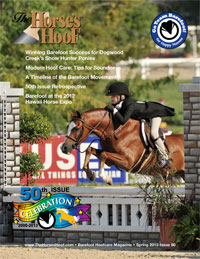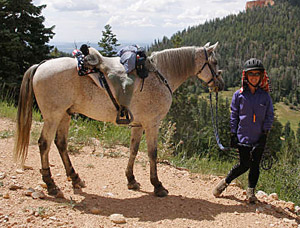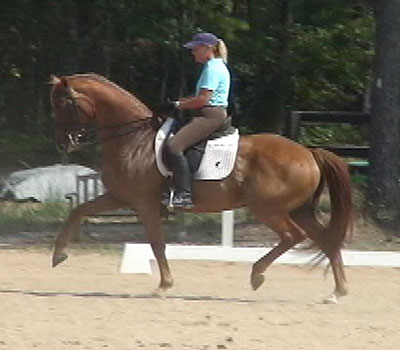Howdy folks,
Yvonne Welz
started The Horse's Hoof magazine in 2000, as a way to create a place where
people can gather to learn and share knowledge and resources about the
"barefoot paradigm." Back then it was a simple folded newsletter sent
out to a few hundred subscribers. She and her husband had been following and
learning all they could about the barefoot movement and it was an announcement
by Jaime Jackson that year that he was discontinuing his newsletter, "The
Hoof Care Advisor" that worried Yvonne.
That announcement
jolted many barefoot enthusiasts and inspired Yvonne to create "The Horse's
Hoof." "Thanks to Jaime, Dr. Hitrud Strasser and Sabine Kells, the barefoot
movement was really just beginning to get noticeable traction. It worried me
that the loss of this resource for people trying to understand and learn the
health benefits of the barefoot lifestyle would create a void. Just beginning
to really understand how important a barefoot lifestyle is to the horse, I felt
committed to do the best I could to keep the momentum going." Yvonne said.
Keep the momentum
going is what she and her husband did. For twelve years they've kept on stride
and this month's issue of the quarterly magazine is issue number 50. Now a
beautiful 32 page full color magazine packed with resources, advice and
contacts to help everyone who is yearning to care for their horses following
the barefoot lifestyle can find help, encouragement, answers and friends.
 |
| The 50th issue! |
Yvonne and James
first discovered the barefoot paradigm when, in May 1999, Yvonne's dressage
award winning Lipizzaner cross mare, Inty, foundered the day after winning a
major competition. Of course the knowledge at the time suggested it had,
"just happened," but now Yvonne realizes it had been a long time in
"happening." They enlisted the aid of the very best care a noted
veterinarian could give, which included invasive hoof surgery, and shoeing.
Inty continued to worsen, becoming so sore she would lie down for days at a
time.
Frantic, Yvonne
dove into the internet to find alternative answers to save Inty. Her search led
her to discover Dr.Hiltrud Strasser's book being offered on Jaime Jackson's
website, and all the information just beginning to emerging about how to promote
a healthy horse through a healthy hoof. Things began to make sense; she and
James quickly began to realize this was the true answer to helping Inty. To
that end James traveled to Canada in the fall of 1999 to study under Sabine
Kells. When James returned the following weekend and began to apply what he'd
learned at Sabina's clinic, they saw the first progress in Inty.
Inty's journey
back to health continued to lead Yvonne and James, and in the spring of 2000
James traveled to Texas to attend Dr. Hiltrid Strasser's first appearance in
the USA. So impressed was James with what he learned there, he enrolled in Dr.
Strasser's year long course. Through the years, he continued to study, from a
wide variety of sources, and developed his own unique, detailed trimming system.
Today, James not only has a thriving barefoot care business, but also a website
community where folks can drop in to learn the Welz trimming system, exchange
ideas and learn the benefits, and how to trim their own horses, and much more.
For your horse's sake, check it out here – www.hoofhelponline.com - This is a
subscription site but you can sign up with a free one day trail to take a look.
 |
| TBR Granite Chief and Karen Chaton winners of the Arabian Horse Association's High Miliage Award in 2004 & 2005 go barefoot and with boots. |
The Horse's Hoof
Magazine continues to grow, reach out, offer help, advice and encouragement. At
the website - www.thehorseshoof.com - you'll find all manners of helpful links and
pages, everything from a trimmers list to horse lover's corner where you'll
find touching stories. I encourage you to subscribe to The Horse's Hoof
Magazine, for your horse. And tell your friends!
The knowledge
Inty inspired Yvonne and James to pursue not only gave Inty a few more years of
life, but charted a new course for their lives. That course is a devotion to
bringing together people who believe in the barefoot paradigm, and offering
assistance to folks just beginning to explore the barefoot lifestyle for their
horses. Good Job, Yvonne and James. And thank you Inty for guiding them!
Gitty Up ~ Dutch
Henry









